Iranwire – More than 10 months after the start of what UN experts described as “targeted chemical attacks” against girls’ schools across Iran, the cause of the sudden illness of thousands of pupils still remains a mystery.
In an attempt to shed light on the reasons for the chain poisonings, which broke out last year amid nationwide protests led by women and girls, a coalition of doctors, pharmacists, scientists and activists inside and outside Iran has collected information and samples from victims and regarding poisoning cases. The intention is to conduct medical analyses and testing.
The Investigation Alliance of Chemical Attacks in Iran (IACAI) includes the US-based International Iranian Physicians and Healthcare Providers Association (IIPHA), the Volunteer Doctors of Kurdistan, the French-based We Are Iranian Students (WAIS) and Canada’s All 4 Iran, among other organizations.
“This group consists of 17 members and includes doctors from all over the world, as well as organizations and associations dedicated to healthcare from across the globe. It’s a coalition of 10 organizations,” IACAI spokeswoman Soheila Anzali tells IranWire in a telephone interview from Germany.
The poisonings were first reported in the city of Qom in late November 2022, only a few weeks after the eruption of the Women, Life, Freedom protest movement. The poisoning cases spread to hundreds of schools, leaving as many as 13,000 girls with symptoms including coughing, difficulty breathing, nose and throat irritation, heart palpitations, headaches, nausea, vomiting and numbness in limbs. The latest such incident was reported in Tehran province on October 7 of this year – meaning that the situation remains active.
Iranian authorities have failed to adequately investigate and end the attacks, and some officials dismissed girls’ symptoms as “stress,” “excitement” or “mental contagion.”
But many Iranians and human rights activists believe schoolgirls have been intentionally targeted for their involvement in nationwide protests sparked by the September 2022 death in police custody of 22-year-old Mahsa Amini.
Anzali says the IACAI “has been collecting epidemiological data from students affected, mapping the geographical distribution of the schools targeted and scrutinizing the symptoms of poisonous gas exposure from students.”
For that, the alliance “distributed questionnaires to students in Iran for reporting their experiences” and “started collecting samples from children’s clothing and garments, such as robes, hijabs, scarves, and other fabrics, to detect any odors.”
The alliance has also obtained hair samples which are being tested.
“It is likely that we will receive the laboratory results by the end of this month,” Anzali says, expressing confidence that they will “eventually provide a conclusive answer” on whether nerve agents were used against Iranian girls.
The IACAI will also prepare a report with its findings to be presented to the United Nations, which she hopes will “trigger meaningful action” by the international community.
 Shabtabnews In this dark night, I have lost my way – Arise from a corner, oh you the star of guidance.
Shabtabnews In this dark night, I have lost my way – Arise from a corner, oh you the star of guidance.



